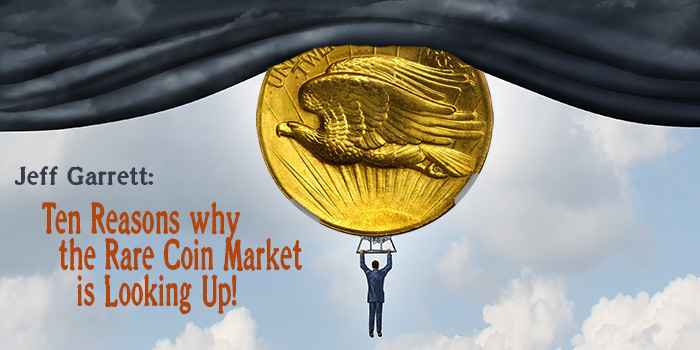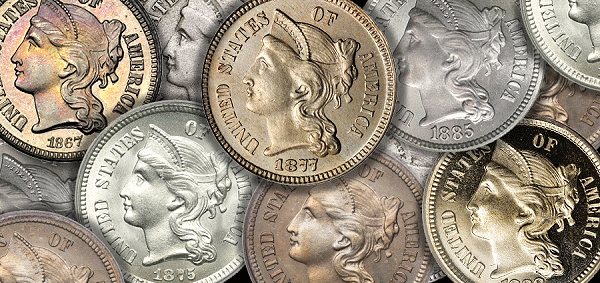
Ten reasons to be excited about the future of numismatics
By Jeff Garrett for Numismatic Guaranty Corporation (NGC) ……
Nearly everyone who is deeply involved with numismatics can attest to the fact that the rare coin market has been soft or depressed in the last few years. Coin prices for many series have drifted downward, some to historic lows. There are a lot of coins that can be purchased for prices last seen in the 1980s. I have highlighted a few of these series in recent months, and plan to discuss several more in the coming weeks and months.
Despite the lower prices for many series and issues, the prices for extreme rarities and grades have been solid, if not higher. In the last five years, a lot of great coins brought record prices at auction. The demand for mega coins far outstripped the limited supply. A few big payers have had a tremendous impact, competing with each other to build registry sets of the finest known coins.
Other collectible fields have seen similar demand for the top end of the market. The extreme wealth of some Americans has greatly benefited everything from fine art to vintage automobiles.
 These mega coins have very little impact on the average collector or dealer. I would love to sell million-dollar coins, but they seldom are offered privately, and usually sell at auction. Coins in this price range are only fantasies for most collectors. They can be fun to read about, but owning them would be impossible for all but a handful of well-heeled collectors.
These mega coins have very little impact on the average collector or dealer. I would love to sell million-dollar coins, but they seldom are offered privately, and usually sell at auction. Coins in this price range are only fantasies for most collectors. They can be fun to read about, but owning them would be impossible for all but a handful of well-heeled collectors.
I have been following rare coin trends for decades, starting in the mid-1970s. Until recent years, the rare coin market has been much more volatile. In January of 1980, a Gem Proof Three Cent Nickel sold for about $2,500 USD. A few months later, they had crashed to under $500. This up-and-down cycle for rare coins played out many times over the next 30 years. The lowest point in the rare coin market that I have personally experienced was in the summer of 1982. Nearly every major rare coin dealer was broke or nearly so. By 1989, the market had roared back.
Starting around the year 2000, the prices and the market for rare coins seemed to stabilize a great deal. I believe the invention of the internet had much to do with this. The market for rare coins was spread out significantly due to access, and the supply of rare coins didn’t overwhelm demand, as it had in the past. Access to numismatic information also greatly helped the hobby. Today’s collectors have far more tools than collectors of the past to make purchase decisions.
 The current market malady started several years ago after the financial crisis. Simply put, the supply of rare coins outpaced the demand. A lot of great collections entered the market, with mega sales of the Newman and Gardner collections being just a couple of examples. The stock market also performed amazingly well during this time period and a lot of money was allocated to that asset instead of to numismatics.
The current market malady started several years ago after the financial crisis. Simply put, the supply of rare coins outpaced the demand. A lot of great collections entered the market, with mega sales of the Newman and Gardner collections being just a couple of examples. The stock market also performed amazingly well during this time period and a lot of money was allocated to that asset instead of to numismatics.
The point of this article is that I feel we may have seen the worst of the recent downturn in rare coin prices. There are quite a few indicators that have given me hope that the lows of this recent market downturn are behind us:
- Coin show activity: I attend almost every mid-size and major coin show in the country. I have been doing this for decades, and this has given me great insight into the pulse of the market. Nearly every coin show I have attended in recent months has been much busier. There is an actual buzz on the bourse floor that anyone who frequents the coin show circuit would recognize. Sales are much stronger across the board for everything, with the exception of unattractive material.
- Rare coins are harder to find: There are considerably fewer exciting coins to be found on the bourse floors than in previous months. Everyone is complaining about the lack of fresh material.
- Demand has increased: Nearly every large retail company in the country is scrambling to find coins for their operations. All of these web retail sites and telemarketing operations are having a hard time acquiring coins for the increased sales.
- Collectors have become more active: The stock market slide in recent months may have convinced a lot of people that it’s a good idea to diversify. There is clearly a lot of fresh money coming into the market.
- Auction prices have been strong: Recent auctions have been very strong for attractive collector’s coins. A few specialty sales, such as the recent Heritage auction of $10 Dollar Liberties, have seen astounding prices.
- Generic gold coins have finally hit rock bottom: Prices could not have gone down much more, with lower-grade $20 Double Eagle gold coins finally ending up in the melting pot. In recent weeks, there has been a smattering of increased premiums and attention to this decimated part of the market.
- ANA membership has increased: While President of the ANA from 2016-2017, I tried everything in my power to increase membership. Sadly, it would not budge. I took stabilization as a victory. In the last several months, membership has increased by about 5%!
- Young people have discovered the hobby: Contrary to what you may read from some pessimists, there are actually a lot of young people who love rare coins. Many very talented young folks have chosen numismatics as a career in the last few years. A lot of them love the combination of numismatics and modern technology. You old guys reading this had better watch out!
- Modern mint product sales have fallen: The US Mint sales of its bullion and commemorative programs have fallen for the last few years. A lot of the attention given to this part of the market by large rare coin companies is now being diverted to vintage numismatics.
- Numismatics has discovered social media: Several months ago, I wrote an article about the Facebook group Coin Dealers Helping Coin Dealers. The group has continued to grow and is now the largest dealer network in the United States with about 800 members. A lot of business is being conducted by the group every day. It turns out that mobile devices and social media could be a major driving force in the hobby in coming years.
The future is never guaranteed for any hobby or business, but from my observations, numismatics is poised for greatness in the next few years!






Those promoting the rare coin market always tout the gains of elite power coins that are well beyond the reach of most but the most affluent collectors. The reality is that this article is a bunch of nonsense. Just to give one example, if you bought a so-called common date slabbed MS 65 barber half, the appreciation on that coin for the past 20 years is virtually nil. The same is true for numerous examples of MS-65 type coins that are not rare dates. I collect coins because I enjoy the hobby, the beauty of high end graded pieces but do not expect much appreciation. Unless an individual is prepared to pay 150K or more for individual power coins, expecting to make a bunch of money through appreciation is a pipe dream.
@Chris Beyer – It’s even worse factoring in inflation.
I certainly disagree with the previous comment that this article is a “bunch of nonsense.” Admittedly many, if not most, coin prices have not increased over the past 20 years. Many have significantly decreased, and, as noted, inflation makes the picture worse. However, that was pretty much what the author said in the first paragraph of his article. So, by agreement, that isn’t nonsense. It is also true that collectors might be better-served to collect coins for the enjoyment of the hobby rather than for price appreciation. I happen to agree with this point but that is nothing more than my individual value judgment. On a 30 to 60-year timeframe, many coins have considerably escalated in value rewarding those who began collecting for value appreciation. So, given the admitted prior flat and/or decreasing prior market, buying now for value appreciation may not be a pipedream for the future. However, the point of the article was neither coin value appreciation over the preceding 20 to 30 years or whether coin collecting should be pursued for enjoyment or price appreciation.
The point of the article was simply the author’s opinion that coin price market might be finally bottoming out. Rather than “a bunch of nonsense,” in my view, the article was well-written and well supported. The author listed a substantial number of broad-ranging empirically verifiable facts to support his theory based upon his training and lengthily experience as a coin dealer and former ANA President. None of the author’s factual observations were challenged as inaccurate or untrue. Therefore, assuming the author’s facts and observations are accurate, it is left to the reader to decide whether an increased coin show activity and sales, increased demand, supply diminution, increased ANA membership, stabilizing auction prices, new social media impact, and the other factors cited by the author sufficiently support the theory that the coin price market may be bottoming out.